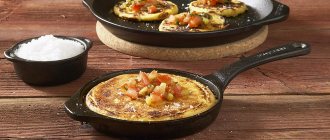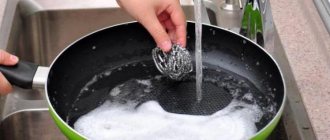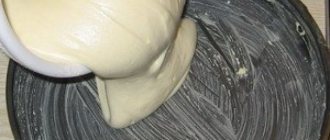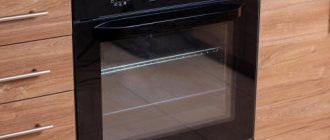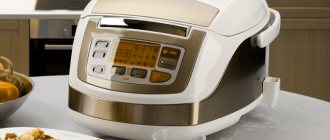It often happens that a favorite frying pan, in which more than one dish has been cooked, suddenly begins to spoil the food. To prevent food from sticking, there are several ways to restore kitchen utensils to their former properties and prevent further food burning. All restoration methods do not require the use of hard-to-find materials and can be easily applied at home.
Reasons why food burns on dishes
As a rule, a frying pan burns for a reason. Certain conditions must be created. This often happens due to:
- purchasing a low-quality frying pan. Companies that respect their reputation produce dishes that last at least 2-3 years. A second-rate fake deteriorates in the first year of use;
- mechanical damage. This is due to the use of metal knives, spatulas, forks for stirring and sponges for cleaning, and storing pans one inside the other;
- expiration date. Consider quality and material when calculating service life;
- sudden temperature changes. Do not move the pan from a hot stove to the refrigerator and vice versa;
- the use of abrasive cleaning agents that disrupt the structure of the surface on which they are applied;
- increased porosity of metal (aluminum, cast iron and enamel).
Liquid products
In the household appliances departments of hardware stores, special liquids are sold that are designed to dissolve even the hardest fat deposits. The components of the liquid actively react with fat, dissolving it before our eyes. These products are much more effective at descaling a frying pan than traditional methods, but their cost is very high.
Carbon remover
Such measures are recommended to be applied either to branded dishes, or if traditional methods do not hit the scale. A clean Teflon frying pan greased with it is preferable due to the harmfulness of the ceramic coating.
What to do?
There is no universal means for removing burnt marks from the surface of a frying pan. It is important, first of all, to consider what material it is made of. Only then, having studied all its features, you can start cleaning.
Cast iron
It is durable. The following tips can help in the fight against burning:
- Initially, when purchasing, rinse it thoroughly, dry it, pour salt 1 cm high, place it on a heated stove, stirring the salt for an hour.
- If it has already been in use, remove the burnt marks, wash, dry and bake it on the stove. Next, you need to coat it with oil both on the outside and on the inside and place it in the oven, after turning it upside down and placing foil under it (provided that the handle is not made of wood). Set the temperature regulator to 180 degrees, let it stand in the oven for an hour, turn it off and, without removing it, wait until the utensil has cooled down. Take it out and try not to use it for a while (3 days - a week).
Aluminum
Similar care is required after purchase. If the dishes start to burn over time, you can revive them as follows:
- wash, heat over medium heat;
- cut the bread into cubes and distribute it over the entire inner surface;
- reduce the heat and fry it for 5 minutes.
Non-stick coating
It seems that it should be the most protected, but food also burns to it. The reason for this is the thinning of the protective layer. Unfortunately, it cannot be restored. The frying pan is sent to a well-deserved rest, especially if it has served for a very long time. If it becomes unusable quickly, the reason for this may be an initially very thin layer of non-stick protection or improper operation.
Effective ways to clean soot from frying pans
Try boiling water with grated laundry soap in it for 15 minutes. You should drain this liquid, wipe the bottom with a sponge, dry it, rub it with oil and try to fry the food. If it doesn’t help, then you’ll have to say goodbye 100% to the utensils.
Enameled
It is prone to burning, as it has a porous structure and is one of the most problematic in terms of the fact that it cannot be heated. The only way to save utensils is by using cleaning products and lubricating its surface with a piece of lard or fat.
Ceramic
This is the most harmless option for the human body, but despite this advantage, it does not last long. Under ideal conditions it lasts from 2 to 4 years.
If it burns, you should:
- Wash thoroughly without using metal sponges or deforming cleaning agents;
- For stubborn stains, pour soapy water over the stains or sprinkle moistened baking soda on the stains and let stand for about 20 minutes. After time has passed, clean with a melamine sponge.
For preventive purposes, every month, wipe the utensils with oil 1-2 times using a napkin and let them stand like that for a day.
Stainless steel
The material is distinguished by its reliability and durability, so any problems that arise are associated with violation of the rules of use. Stainless steel cookware lasts for decades, given that the ratio of chromium to nickel in steel is 18 to 10.
Help:
- clean and rinse (any items and types of cleaning products are acceptable) until shiny;
- remember the rules for further operation (heating should be strong until drops of water “dance” and the oil poured before frying should have time to heat up).
These recommendations will help prevent further episodes of burning.
Grill
Has a grooved bottom. It is made from the same materials as conventional ones, therefore, in order to choose the most suitable anti-stick option described above, you need to find out what metal it consists of.
Use olive oil
A small amount of oil on the bottom of the pan is one of the most effective ways to keep food from burning.
Pour some oil into the pan and spread it evenly with a paper towel to cover the entire bottom.
Before you start frying, you need to wait until the pan is hot (not until the oil starts to burn, of course).
If only the middle burns
The phenomenon in which burns form only in the middle is associated with heating devices. This problem most often occurs among those who use gas burners. The heat is distributed unevenly along the bottom, and the greatest heat occurs in the center of the pan. The heat from the flame does not dissipate and is directed directly. With large cookware, the food in the middle cooks much faster during the cooking process, which contributes to the formation of soot. You can solve the problem by purchasing a frying pan with a smaller diameter. It is also effective to use a special device that cuts through the fire and distributes heat over the entire bottom area.
Cast iron frying pan: how to heat it and why it is needed
Gels and creams
The most concentrated professional products are produced in the form of gels and creams, which are designed for quick and effective cleaning of pans from fatty deposits of any complexity.
Gel for removing fat deposits.
They can be applied outside or inside the surface of the frying pan with gloved hands or a special brush. Fat, which loves to stick to metal, will literally dissolve before your eyes, leaving residue that needs to be washed off with plain water.
How to avoid burning?
Before use, prepare the frying pan: wash it thoroughly and wipe it with oil or fat. Those utensils made of cast iron require calcination of 1 cm of poured salt for an hour.
Adviсe:
- Lubricate with plenty of oil, lard or fat before each use.
- After distributing it evenly, pour a little salt on the bottom and heat the frying pan.
- For those made of porous metals (cast iron, aluminum), pour apple cider vinegar and wait until it evaporates over low heat.
- After the described procedures, start cooking.
- Stirring food should not be done with spoons, iron spatulas, knives or anything that has a hard surface. This can leave scratches that compromise the protective layer and damage the pan. The most optimal are items made of wood or plastic.
- When washing, avoid hard sponges and brushes. Cleaning agents are not recommended. The best option is good old baking soda diluted with water.
- The dishes should be wiped dry. This will prevent mold and rust from forming, which can reduce the non-stick properties.
- Pans should be stored separately from each other, without stacking them. This ensures the safety of their surface.
Treatment
Many people are interested in what to do if a frying pan burns? To prevent this, special preparation is needed. Containers made of cast iron and aluminum are calcined before use. The following tips will also be helpful:
- For both materials, the processing option is the same - the container must be washed with warm water, dried, and placed on low heat.
- Pour vegetable oil into the bottom of the dish and heat it for at least 40 minutes.
- Then the pan cools down, the oil must be drained, and the dishes must be wiped with paper napkins to remove fat.
- The container remains in this form for several days, and then it needs to be washed and can be used. As the metal heats up, it expands and oil penetrates into the pores. This serves as protection; the bottom of cast iron or aluminum becomes smooth. Food will not stick or burn.
The procedure should be repeated, since the protective film is destroyed with use. Heat the pan and add salt. Enameled cookware cannot be heated. The only solution to prevent the problem is to clean it with detergent, after which the container should be dried and rubbed with a piece of fat. This should be done before each cooking to prevent it from sticking.
Caring for frying pans
Tips for caring for a frying pan depending on the material from which it is made.
Teflon coated
It does not require special care. Thanks to Teflon, it independently prevents the formation of soot both inside and outside. If it does appear, then you need to fill the frying pan with hot water for half an hour. For greater effect, you can add a drop of detergent or add 3 tbsp. spoons of baking soda. The carbon deposits will dissolve without the use of prohibited abrasives. Wipe it with a soft sponge.
It is important to remember that the Teflon coating is easily damaged.
Stainless steel
Steel is the most finicky metal from which cookware is made. A minor defect is immediately visible, and food easily burns to the surface.
Frying pan with ceramic coating: pros and cons, how to choose
You can clean carbon deposits from stainless steel using table salt, soda or vinegar with citric acid.
Cast iron
They are practically eternal, unpretentious and harmless. Cast iron frying pans can be called eternal. They are absolutely easy to care for and do not release harmful substances into food. In addition, they do not lose their appearance even over the years. All you have to do is clean off the carbon deposits in a timely manner. There are several recipes for the best ways to get rid of it.
For cast iron frying pans, care recipes intended for steel ones are suitable. You can also use both baking soda and citric acid vinegar. In addition, cast iron is not afraid of contact with abrasives, so you can safely clean them with brushes and metal sponges.
Ceramic
They are becoming more and more popular. Its surface is smooth and uniform. They are one of the easiest to care for. Any scratch can make the frying pan unusable, so you need to purchase special products for ceramics to dissolve carbon deposits.
Why did the pan start to burn?
Food can stick to any surface, regardless of whether it has an additional protective coating or not. For non-stick kitchen utensils, the cause of food sticking may be a poor-quality product (manufacturing defect) or surface wear. Teflon, titanium, marble, and other types of cookware have an expiration date. Before you understand what you need to do to prevent the pan from sticking, you should understand what factors contribute to food sticking.
The main reason why food starts to burn is the porous surface of the kitchen product. Aluminum, cast iron and enamel cookware have this structure.
Removing food debris
If a new frying pan, which has been in use only a few times, suddenly begins to burn, the cause may be improper care of its surface. Many housewives use harsh chemicals or harsh abrasives to remove food debris. They negatively affect the technical condition of kitchen utensils. But, if you don’t completely clean the walls and bottom of food particles and start preparing the next dish, the food can also burn.
Service life of pans
| Material from which the frying pan is made | Life time |
| Cast iron | Decades |
| Stainless steel | Up to 6-10 years |
| Ceramics | From 3 to 5 years |
| Aluminum | From 3 to 8-10 years |
| Non-stick coating | From 3 to 10 years (depending on texture) |
| Enameled | Becomes unusable after any damage |
Cleaning with office glue
Stationary adhesive can significantly improve the properties of laundry soap.
Stationary glue
Based on it, a special solution is prepared, in which you need to prepare a frying pan with a greasy residue or a frying pan with burnt jam. A piece of laundry soap is rubbed into a container that can fit a frying pan. Several tubes of writing glue were also added there. The mixture is stirred until a homogeneous mass is formed, into which the frying pan is placed.
Carefully! When preparing dishes, the hood must be running; glue vapors can be toxic to the human body.
After a while, remove the pan, add plenty of water and a metal scraper to remove any remaining fat, and dry thoroughly.
In addition to glue, you can use ammonia and hydrogen peroxide.
Which pans are the least likely to cause food to burn?
Without a doubt, the leader in this rating is a frying pan with a special protective non-stick coating. But don’t be mistaken about the fact that you can cook with it without oil. It is necessary, only much less is required. A drop is enough. An additional advantage: you do not need to closely monitor the heating process.
At the end of the list are frying pans that have a porous surface. For example, cast iron. It requires a large amount of oil for coating and frying, so that it forms a layer that protects against the formation of burning.
The most difficult case is steel cookware. Metal is finicky: it heats up unevenly and quickly, requiring more oil and thorough heating.
Cleaning
If a ceramic frying pan is burnt, what should you do? If the dishes are still damaged, you need to do the following:
- The pan needs to be washed.
- Then it is dried.
- The surface should be rubbed with vegetable oil.
- The impregnation should be left for several days.
- Then you need to wash off the remaining oil with warm soapy water.
This completes the procedure for cleaning the ceramic surface. Proper care of your cookware will extend its service life.
How to choose a pan so that nothing burns in it
- It is better to choose an enamel pan, in the manufacture of which the enamel was applied not by spraying, but by dipping - this will be indicated by 2-4 dots on the bottom.
- Cast iron should have thick walls. This material is dark in color and the surface is porous.
- Teflon products must have several layers of spraying. At the same time, such utensils must be handled very carefully so as not to damage the protective layer.
- Ceramic - must be thick-walled. The thicker the walls, the more evenly the heat will be distributed, eliminating burning.
Choosing good kitchen utensils - video
Activated carbon
Suitable for materials: ceramics, enamel, stainless steel, aluminum, cast iron.
Type of soot: porridge, milk.
Instructions:
- Grind 3-4 tablets of activated carbon into powder.
- Fill the bottom of a pot or pan with powder.
- Let stand for 30 minutes.
- Carefully pour cool water so as to cover the remaining food, let it brew for another 0.5 hour.
- Wash with traditional detergents.
It is not advisable to use strong alkaline products to clean aluminum products, because... It is easy to damage the smooth surface.
Cleaning stainless steel from carbon deposits - video
Vinegar
Suitable for materials: aluminum, enamel, ceramics, cast iron, stainless steel.
Type of burnt product: jam, sugar, porridge, milk.
See also: How to Grill Corn
Instructions:
- Pour table vinegar over the contaminated areas.
- Cover and let stand for 1.5-2 hours.
- Clean using traditional methods.
Instead of vinegar, use citric acid or freshly squeezed lemon juice, but their effect will be less pronounced. This method also helps well against dark carbon deposits on the outside.
Salt
Suitable for materials: aluminum, enamel, ceramics, cast iron
Type of soot: porridge, pasta, jam, sugar.
Instructions:
- Fill the pot or pan with water and let it sit for 0.5-1 hour.
- Cover the soot with salt so that it covers all dirty areas.
- Let stand for 2-3 hours.
- Clean with a sponge.
Do not pour cold liquid into hot enamel cookware - this will lead to microcracks and damage to the coating. Wait until it cools down.
Non-stick coating restoration workshops
Restoring Teflon coatings has recently become possible. Workshops are opening that specialize in high-quality replacement of non-stick coatings. They have special equipment with which they apply a new layer of polymer. The companies guarantee that the dishes will be returned to their original appearance and functionality. The service is not cheap, so sometimes it is more profitable to buy a new frying pan.
It does not matter what material the kitchen products are made of if care is neglected. It is necessary to use the utensils correctly and carefully and periodically carry out preventive measures to extend their shelf life.
